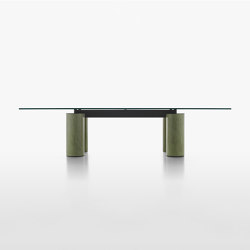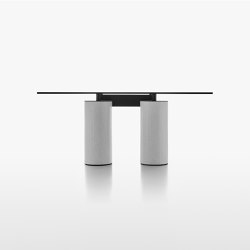SERENISSIMO
Dining tables from Acerbis, Designed by Lella Vignelli, David Law, Massimo Vignelli
- Family gallery
- Family gallery
- Family gallery
- Family gallery
- Family gallery
- Family gallery
Product description
With the precision of its contours, Serenissimo translates the concept of the table into a graphic composition with four columns and a horizontal steel bar that makes the table top
appear to float. In line with Lella and Massimo Vignelli’s original design, it is an object that expresses itself through its geometry and materials: basic shapes characterised by metallic finishes or soft encaustic tones.
Structure
The structure consists of 4 cylindrical bases (Ø 28 cm) made with a steel tube, painted in either a gun-metal grey or orbital bronze finish, or, in Encausto’s more tactile variations, in the colours terracotta, green, and white. The metal frame that holds together the 4 bases and supports the table top is painted micaceous grey.
Top
The tops are available in either a square or rectangular version
and in the following finishes:
_ transparent glass, float glass plate characterized by transparency. Thickness 15 mm;
_ extra clear opalescent glass, float glass plate with smooth and glossy upper side, acid-etched lower side.
Thickness 15 mm;
_ cast glass, glass plate hot molded with smooth and glossy upper side, wrinkled (for casting) and semi-transparent back-lacquered lower side, in the colours black, mustard yellow, English green, pink. Thickness 15 mm;
_ lacquered frosted white glass, float glass plate with acid-etched upper side (silky effect to the touch), and back-lacquered lower side. Thickness 15 mm.
Encausto: also known as “Venetian stucco”, encausto uses a highly sophisticated technique in which a fine sand plaster is applied in successive layers, the last of which is coloured with natural earth. In this stage a fluidmalleable mixture of limewash is used to burn the colour, changing it as it dries (in
fact, “encausto” is a Latin term that derives from the Greek word “enkaustikos” or “to burn in”). In the “tallocciatura” phase, which refers to the process of manually smoothing the plaster through the skilful use of a spatula, the coloured mixture is unevenly incorporated in the plaster, giving the surface the characteristic appearance of this ancient artisan tradition.
Size
Rectangular: L250xD120 - L300xD120 - L350xD120*. Square: L160xD160 - L180xD180 - L200xD200*.
H72 cm.
appear to float. In line with Lella and Massimo Vignelli’s original design, it is an object that expresses itself through its geometry and materials: basic shapes characterised by metallic finishes or soft encaustic tones.
Structure
The structure consists of 4 cylindrical bases (Ø 28 cm) made with a steel tube, painted in either a gun-metal grey or orbital bronze finish, or, in Encausto’s more tactile variations, in the colours terracotta, green, and white. The metal frame that holds together the 4 bases and supports the table top is painted micaceous grey.
Top
The tops are available in either a square or rectangular version
and in the following finishes:
_ transparent glass, float glass plate characterized by transparency. Thickness 15 mm;
_ extra clear opalescent glass, float glass plate with smooth and glossy upper side, acid-etched lower side.
Thickness 15 mm;
_ cast glass, glass plate hot molded with smooth and glossy upper side, wrinkled (for casting) and semi-transparent back-lacquered lower side, in the colours black, mustard yellow, English green, pink. Thickness 15 mm;
_ lacquered frosted white glass, float glass plate with acid-etched upper side (silky effect to the touch), and back-lacquered lower side. Thickness 15 mm.
Encausto: also known as “Venetian stucco”, encausto uses a highly sophisticated technique in which a fine sand plaster is applied in successive layers, the last of which is coloured with natural earth. In this stage a fluidmalleable mixture of limewash is used to burn the colour, changing it as it dries (in
fact, “encausto” is a Latin term that derives from the Greek word “enkaustikos” or “to burn in”). In the “tallocciatura” phase, which refers to the process of manually smoothing the plaster through the skilful use of a spatula, the coloured mixture is unevenly incorporated in the plaster, giving the surface the characteristic appearance of this ancient artisan tradition.
Size
Rectangular: L250xD120 - L300xD120 - L350xD120*. Square: L160xD160 - L180xD180 - L200xD200*.
H72 cm.
Concept
Table with a unique and timeless design in which the apparent thinness and lightness of the glass top contrasts with the considerable diameter of the columns. These columns acquire greater expressive force from the different colours and textures of the cladding materials: the warmth and distinction of the mesh in bronze metal thread, the shine of the stainless steel, the concrete craftsmanship of the Fresco finish. Added to the common cement paste or grout, generally used as binding in a mixture with inert materials such as sand, marble powder, earths, a special resin is added that permits “fresco su fresco” manufacturing as for frescos and shows lines, speckles, variegated effect and slight dents: all these are marks of the artist’s hand and combine the beauty of different finishes that are never repetitive.
More about this product
Categorised in Tables - Dining tables - Tabletop rectangular - 4-leg base - Glass - Tabletop glass - Concrete - Base concrete - Residential.
Part of the collection
TABLES.
Manufacturer
Acerbis
Family
SERENISSIMO
Architonic ID
1177578
Year of Launch
1985
More products from SERENISSIMO family
Downloads
Manufacturer’s Catalogues
Contact information
Address
Via F.lli Cervi 4/a, 22066 Mariano Comense Italy
Get more information
Sign in to your Architonic account to have your contact details filled out automatically for each request.
Where to buy this product

More from
AcerbisContact information
Address
Via F.lli Cervi 4/a, 22066 Mariano Comense Italy
Where to buy this product



